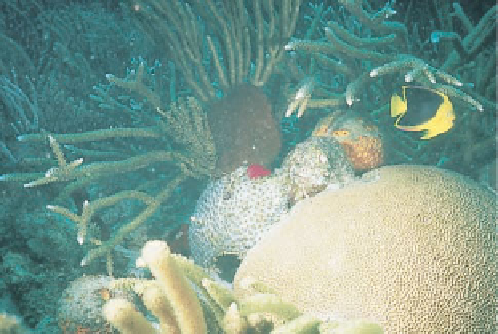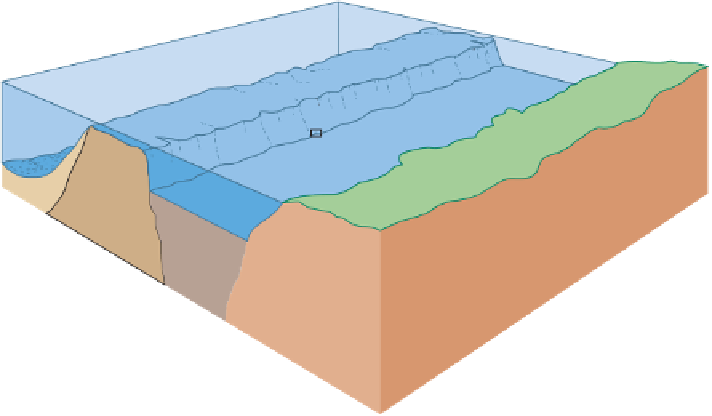Geology Reference
In-Depth Information
◗
Figure 20.9
Organic Reef
a
Present-day reef community showing various reef-building
organisms.
Reef flat
(a)
Back reef
Open sea
Reef core
Lagoon
Land
Talus
b
Block diagram of a reef showing the
various environments within the reef
complex.
Fore-reef
slope
Barrier reef
Lagoon
increasingly concentrated, the precipitation of salts would
occur. A second possibility is that the reefs grew upward so
close to sea level that they formed a sill or barrier that elimi-
nated interior circulation and allowed for the evaporation
of the seawater that produced a dense brine that eventually
resulted in evaporite deposits (
Mississippian) is marked by a major unconformity. As the
Kaskaskia Sea transgressed over the low-relief landscape of
the craton, most basal beds deposited consisted of clean,
well-sorted quartz sandstones.
The source areas for the basal Kaskaskia sandstones were
primarily the eroding Acadian Highlands (
◗
Figure 20.12).
◗
Figure 20.13),
exhumed Cambrian and Ordovician sandstones cropping
out along the flanks of the Ozark Dome, and exposures
of the Canadian shield in the Wisconsin area. The lack of
similar sands in the Silurian carbonate beds below the
Tippecanoe-Kaskaskia unconformity indicates that the
source areas of the basal Kaskaskia detrital rocks were sub-
merged when the Tippecanoe Sequence was deposited.
Stratigraphic studies indicate that these source areas were
uplifted and the Tippecanoe carbonates were removed by
erosion before the Kaskaskia transgression.
Kaskaskian basal rocks elsewhere on the craton consist
of carbonates that are frequently difficult to differentiate
from the underlying Tippecanoe carbonates unless they are
fossiliferous.
Except for widespread Upper Devonian and Lower
Mississippian black shales, the majority of Kaskaskian rocks
are carbonates, including reefs, and associated evaporite
deposits. In many other parts of the world, such as southern
England, Belgium, Central Europe, Australia, and Russia,
By the Early Devonian, the regressing Tippecanoe Sea had
retreated to the craton margin, exposing extensive low-land
topography. During this regression, marine deposition was
initially restricted to a few interconnected cratonic basins
and, fi nally, by the end of the Tippecanoe, to only the mobile
belts surrounding the craton.
As the Tippecanoe Sea regressed during the Early Devo-
nian, the craton experienced mild deformation, forming
many domes, arches, and basins (Figure 20.1). These struc-
tures were mostly eroded during the time that the craton was
exposed, so they were eventually covered by deposits from
the encroaching Kaskaskia Sea.
The boundary between the Tippecanoe Sequence and the
overlying
Kaskaskia Sequence
(Middle Devonian-Late









Search WWH ::

Custom Search